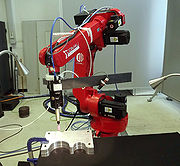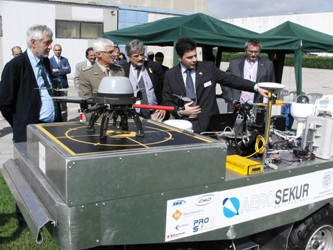FIDELIO: FIxtureless DEburring of wheeLs by human demonstratIOn
Modern industrial robots are complex and powerful machines, able to execute a wide range of different tasks with high speed and accuracy. Nevertheless, they still have a low degree of autonomy and adaptability, and need a human operator to learn new tasks or tune existing ones.
In the last twenty years robotic researchers have been focusing on the Learning From Observation paradigm, developing prototypic robotic systems able to observe and learn from human operations. In this new paradigm, the information coming from a range of observations is analysed and transformed into an abstract representation of the task. By using such information, and exploiting the abstraction capabilities of a suitable cognitive system, the robot is able to autonomously generate a program to reproduce the task, even if the environment is different from the one observed during the learning phase.
The FIDELIO project aims at researching into the feasibility (and the related advantages) of this innovative approach in an industrial application scenario, exemplified by a fixtureless wheel deburring task. To this end, a robotised cell has be set up, composed of a Comau SmartSix industrial manipulator and a workstation where aluminium wheels are placed for deburring. On top of the workstation a camera frames the workspace in order to locate the wheel. The arm is equipped with a pneumatic deburring tool connected to the robot end-effector through a force/torque sensor. In addition, an eye-in-hand camera is mounted at the robot end-effector, framing the cutting tool and the deburring edge.
The experiment focused on three main topics:
- an innovative programming technique based on walk-through programming;
- an eye-in-hand inspection system to measure burrs characteristics;
- a methodology to autonomously learn the deburring skill.
Walk-through programming
In the walk-through programming the human operator plays the role of a teacher that physically walks the robot through the desired path. Furthermore, in an industrial application, like metal finishing or painting operations: the physical interaction between the human operator and the robot should be conceived in such a way that the teacher has the impression to grab a real tool, e.g. a deburring tool or a spray gun, instead of the robot end-effector. The role of the control system is thus to accommodate for the motion commanded by the teacher, mimicking the same dynamic behaviour of the real tool, i.e. behaving like a virtual tool that exhibits the same mechanical properties of the real tool.
QUADRIVIO
The popularity of the research on unmanned ground vehicles has been recently increasing due to their usefulness in different operating environments. Planetary explorations, search and rescue missions in hazardous areas, surveillance, humanitarian demining, as well as agriculture applications such as pruning vine and fruit trees, are examples of potential applications of autonomous vehicles in natural environments. Unlike indoor mobile robotics, where only flat terrains are considered, outdoor robotics deals with all possible natural terrains. The unstructured environment and the terrain roughness including moving obstacles and poorly traversable terrains make the problem extremely challenging. All-Terrain Vehicles (ATVs) are suitable to drive in outdoor environments and through poorly traversable terrains, and compared to other movile platforms can rive at higher speed. ATVs, however, are also characterised by poor stability, roll- and tip-over phenomena, and excessive side slip. Those being the main drawbacks of these vehicles. The QUADRIVIO project aims at developing a low-cost unmanned ground vehicle for search and rescue missions in hazardous areas, possibly after a natural disaster. To achieve this challenging goal the project develops:
- a virtual rider, a low-level stabilisation system, including roll/tip-over prevention and obstacle avoidance mechanisms, that makes the vehicle autonomous at least for short range navigation
- a path planner that finds the best path in presence of rough an sloping terrains, taking into account the vehicle kinematic and dynamic constraints
- an ATV tracking controller that, acting on steer, throttle and brakes, tracks the desired path, ensuring the vehicle stability
A further aim of the QUADRIVIO project is the development of an airdrop system to parachute the vehicle on the operating area when, due to a natural disaster, all the main roads have been seriously damaged.



